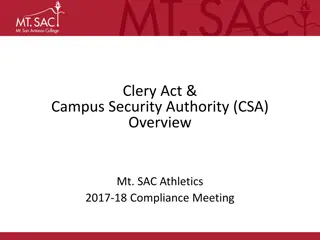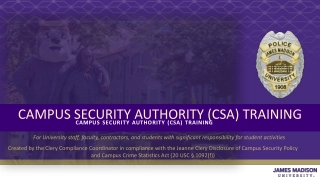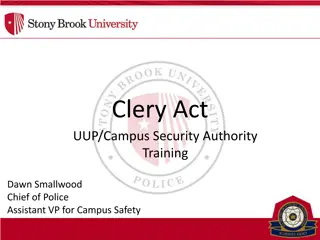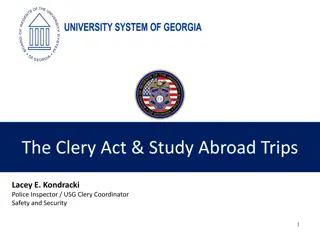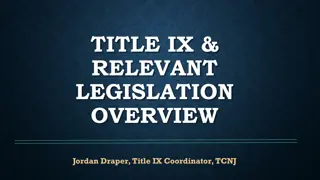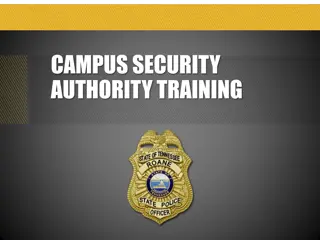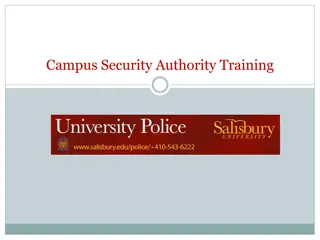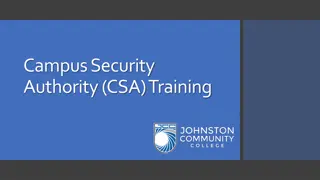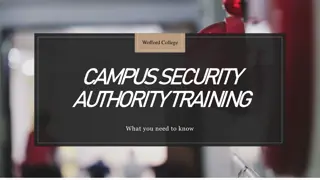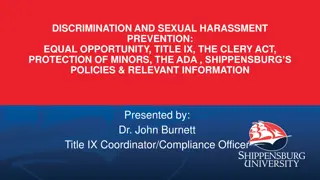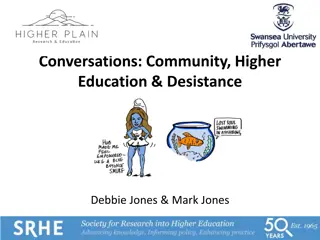Understanding the Jeanne Clery Act and Higher Education Opportunity Act
The Jeanne Clery Act, renamed in 1998, mandates public and private postsecondary institutions to comply with campus security and crime reporting regulations. It requires policy disclosures, record collection, retention, and information dissemination. Additionally, the Higher Education Opportunity Act of 2008 introduces new safety and reporting requirements for colleges. Compliance involves creating and amending policies, annual safety and fire reports, and addressing missing students. Institutions like CSU-Pueblo must provide accurate policy statements, report crimes, and maintain records as part of compliance with these acts.
Download Presentation

Please find below an Image/Link to download the presentation.
The content on the website is provided AS IS for your information and personal use only. It may not be sold, licensed, or shared on other websites without obtaining consent from the author. Download presentation by click this link. If you encounter any issues during the download, it is possible that the publisher has removed the file from their server.
E N D
Presentation Transcript
An Overview of the Jeanne Clery Disclosure of Campus Security Policy and Campus Crime Statistics Act and the Higher Education Opportunity Act Presented by: Michael Nosler, General Counsel Joshua Zugish, Associate Legal Counsel Office of the General Counsel Colorado State University System October 20, 2010
History of the Clery Act and Required Compliance In 1990, Congress enacted the Crime Awareness and Campus Security Act The act was amended in 1992, 1998 and 2000 The 1998 amendments renamed the law the Jeanne Clery Disclosure of Campus Security Policy and Campus Crime Statistics Act in memory of a student who was slain in her dorm room in 1986 All public and private postsecondary institutions that participate in federal Title IV student aid programs must comply with the Clery Act regulations
What Does Clery Require? Three primary categories of Clery requirements: policy disclosures records collection and retention information dissemination
A Note About the HEOA Also, the Higher Education Opportunity Act of 2008 and its accompanying regulations establish new requirements for colleges in the areas of personal safety and crime reporting, fire safety and reporting, and missing students. The HEOA and regulations require: certain changes to the Annual Safety Report the creation or amendment of policies and procedures an Annual Fire Report the HEOA reporting requirements relate to campus safety and are logically reported as part of the Annual Security Report required by Clery
Policy Disclosure CSU-Pueblo must provide campus community and the public with accurate statements of its current policies and practices regarding: Procedures for students and others to report criminal actions Procedures for reporting emergencies occurring on campus Policies regarding security of and access to campus facilities Campus law enforcement
Record Retention and Reporting CSU-Pueblo must keep records of reported crimes: on campus in or on a non-campus building or property, or public property within or immediately adjacent to and accessible from the campus
Record Retention and Reporting Cont. Must report: where the crime occurred the type of crime to whom the crime was reported when the crime was reported
Record Retention and Reporting Cont. Types of Offenses: Murder and Manslaughter Sex Offenses Robbery Aggravated Assault Burglary Car Theft Arson The HEOA adds four new crimes to the annual reporting requirements: larceny-theft;simple assault;intimidation; and damage/vandalism of property. These crimes are only reportable when committed in the context of a hate crime.
Record Retention and Reporting Cont. Must disclose whether any of the offenses were hate crimes Must disclose arrests and referrals for disciplinary action for illegal weapons possession and violation of drug/liquor laws CSU-Pueblo must also make a reasonable good-faith effort to obtain certain crime statistics from appropriate law enforcement agencies, such as Pueblo PD or Pueblo County Sheriff CSU-Pueblo is required to keep a daily crime log that must be open to public inspection.
Fire Safety and Reporting Fire Safety Reporting HEOA and its accompanying regulations require that campuses report on-campus housing facility fire and related incidents in a manner that is similar to crime and incident reporting in the Clery Annual Security Report.
Fire Safety and Reporting The HEOA requires that the new report: describe each on-campus student housing facility report the number of fire drills conducted during the reporting year list the campus policies or rules on portable electronic appliances, smoking, and open flames in a student housing facility list procedures for evacuating student housing in the event of a fire list the policies regarding fire safety education and training programs provided to the student and employees list who students and employees should report a fire to (911) list plans for future improvements in fire safety, if any
Fire Safety and Reporting Only fires that occur within an on-campus student housing facility must be reported Must report on the: number of fires that occur in the residence halls number of injuries or deaths from fires value of fire-related property damage. Include statistics for the three most recent calendar years (phased in from 2010 report) Must also maintain a fire log about nature, date, time, and general location of each fire
Information Dissemination CSU-Pueblo must: Provide a timely warning of any Clery Act crimethat might represent an ongoing threat to the safety of students or employees Provide access to its crime log during normal business hours Publish an annual security report and distribute it to all current students and employees, and inform prospective students and employees about the content and availability of the report Inform the campus community where to obtain information about registered sex offenders
Who is Involved with Compliance? Campus police/security Non-police security staff responsible for monitoring campus property, such as building proctors Individuals and offices designated by the campus security policies as those to whom crimes should be reported; and Officials of the institution with significant responsibility for student and campus activities.
Importance of Compliance DOE can issue civil fines up to $27,500 per violation Public Relations DOE reports are public
Critical Issue -Timely Warnings TIMELY WARNING REQUIREMENT
When is a timely warning required? The Clery Act requires institutions to make a timely warning to the campus community when a report of a murder, sex offense, robbery, aggravated assault, burglary, motor vehicle theft, manslaughter or arson is received by campus law enforcement and, in the judgment of the institution, the crime at issue poses an ongoing threat to students and employees.
What is Timely? Neither the Clery Act nor the regulations define timely. The warning should be issued as soon as the pertinent information is available because the intent of a timely warning is to alert the campus community of continuing threats to safety, thereby enabling community members to protect themselves.
What is Timely? Cont. The Clery Act mandates timely warnings only for Clery Act crimes BUT, nothing prohibits timely warnings for other crimes that may pose a serious or continuing threat to the campus community (e.g., kidnapping).
What Information Must Be Included in the Warning? Clery Act regulations do not specify what information should be included in a timely warning. U.S. Department of Education guidance suggests that warnings include all information that would promote safety because that is the overarching intent of the Act
Considerations in Issuing a Timely Warning? The issuing of a timely warning must be decided on a case-by-case basis in light of all the facts surrounding a crime, including: the nature of the crime the continuing danger to the campus community the possible risk of compromising law enforcement efforts.
Considerations in Issuing a Timely Warning? Cont. DOE guidance suggests the policy on timely warnings specify who, or which office, is responsible for issuing the warnings
How is the Timely Warning Communicated to the Campus Community? The format for the warning has not been mandated, but it must be timely and reasonably likely to reach the entire campus community to aid in the prevention of similar crimes.
How is the Timely Warning Communicated to the Campus Community? Cont. Timely warnings must be issued in a manner that gets the word out quickly communitywide. They may be: e-mailed texted posted around campus a combination of dissemination methods may be used
Timely Warnings vs. Emergency Warnings After the tragic shootings at Virginia Tech and Northern Illinois, most colleges developed emergency notification systems for immediate dangers including active shooters, fires, or severe and dangerous weather New regulations clarify that if procedures on emergency notification are followed in the case of an immediate threat to health or safety, campuses need not issue a timely warning for the same danger Appropriate follow-up information regarding the circumstances should still be provided
Emergency Notification Procedures The Annual Safety/Clery Report must include a statement of policy regarding emergency response and evacuation procedures that includes: the procedures used to immediately notify the campus community of an immediate threat to health or safety a description of the process used to: confirm there is an emergency determine who on campus must be warned determine the appropriate content of the warning, and send the notification. a statement a notice will be sent without delay unless it will compromise the effort to deal with the emergency or rescue a victim; a list of the people tasked with determining whether an emergency exists the campus procedure for disseminating emergency information to the larger community, such as contacting media outlets or updating the website
Emergency Notification Procedures Further, the Annual Safety Report/Clery Report must disclose procedures to test emergency response and evacuation systems at least once per year including: performing tests that are announced or unannounced publicizing the emergency response and evacuation procedures in connection with one test per year, and keeping certain records for each emergency response and evacuation test including: a description of the test; the date and time of the test; and whether the test was announced or unannounced.
Importance of Compliance? DOE can issue civil fines up to $27,500 per violation
Importance of Compliance? Cont. Examples: Eastern Michigan University paid $350,000 in fines in 2008 for "very serious, numerous and repeated" violations of the Clery Act, generally including failing to issue a warning about a murder, a lack of "administrative capability" in complying with Clery, failure to have a timely warning policy, failing to properly disclose crime statistics including forcible sex offenses for each of three years (2003-2005), failing to properly disclose all required security policies for each of three years (2003-2005), failing to properly report crime statistics from outside law enforcement agencies for each of three years (2003-2005), and for failing to properly maintain a public crime log (the murder was logged as a "medical assist" instead of a crime).
Importance of Compliance? Cont. Virginia Tech faces $55,000 in fines for waiting two hours to notify the campus after two shootings that occurred in the morning, 2 hours prior to the even more serious massacre that occurred
Contact Information Mike Nosler Michael.Nosler@colostate.edu Joshua Zugish Joshua.Zugish@colostate.edu


